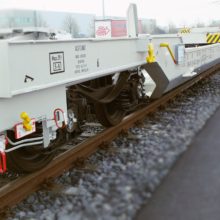
“With this new generation of pocket wagons we are pursuing three strategic goals in intermodal transport”, says Karsten Sachsenröder, the company’s CEO.
“Firstly, we want to meet the demands of our clients, who in addition to containers and swap bodies are increasingly looking for transport options for mega-trailers.” With the Twin I AAE has opened up the market for pocket wagons, which are also suitable for mega-trailers and it has a fleet of 1,000 of these wagons, but they are all fully booked. This is because trailers – and increasingly mega-trailers – have been the fastest growing transport container segment in recent years. Companies want to deploy these very flexible trailers in combined road and rail transport, however, because they do not fit into conventional pocket wagons due to their larger volume there are too few wagons available.
“Secondly, we want to consolidate our role as an innovator and market leader. That’s why we have further optimised the successful Twin I model.” AAE technicians have reduced the tare weight of the six-axle wagon by two tonnes to around 35 tonnes. At the same time they have made the construction design more robust in key areas – such as the hitch for the trailer’s kingpin – and simplified its operation. “The roller beams on which containers and swap bodies are seated are now designed in such a way that they can be quickly and easily rolled and locked into the correct position for each container length by one person. This speeds up handling in the terminals.”

